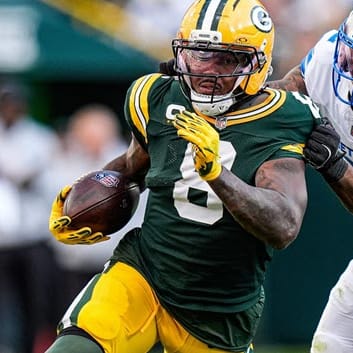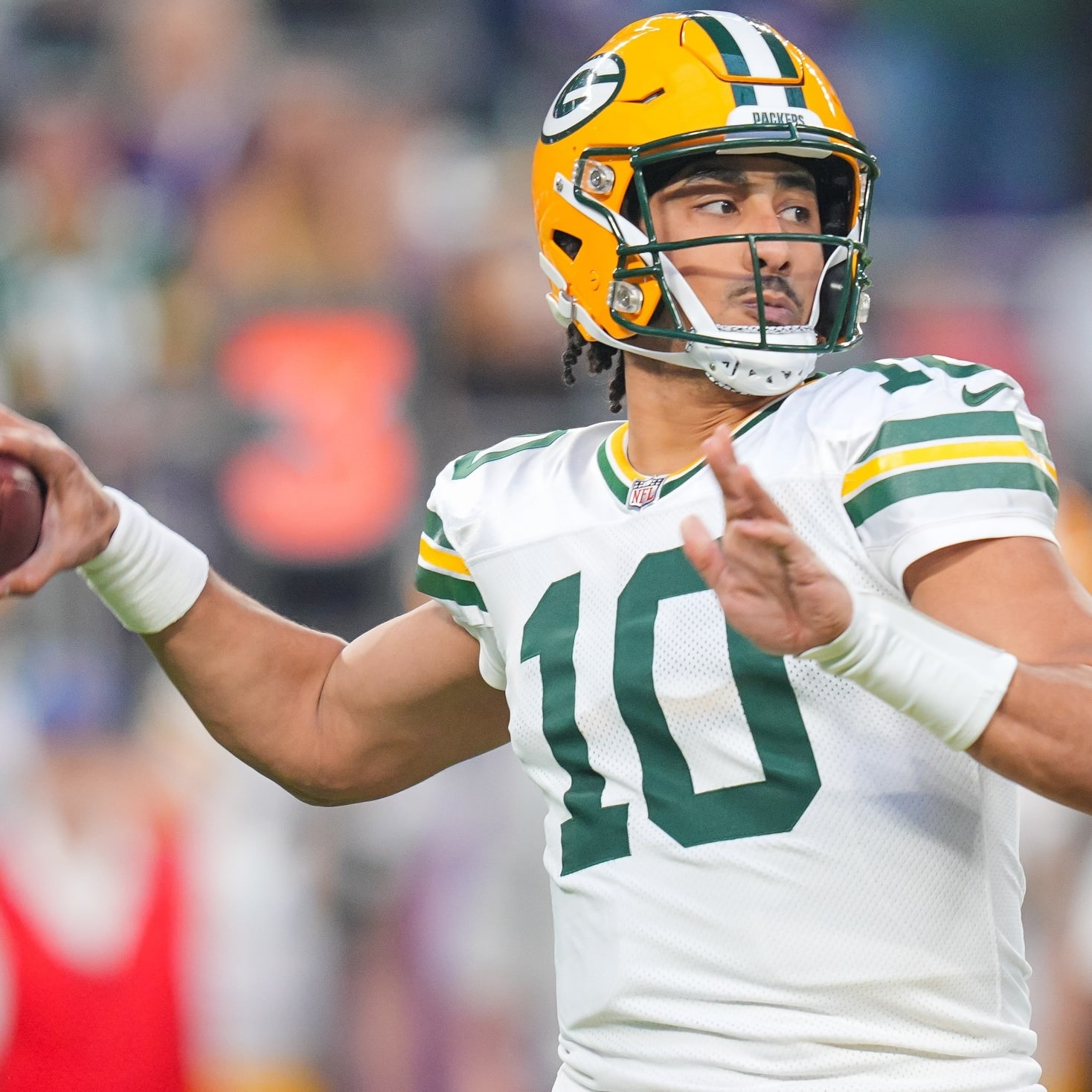These are the post-combine wide receiver rankings, following the running back rankings (click here) and the quarterback/tight end rankings (click here). Like those two articles, this one will include an updated round projection plus a comparison for each ranked player.
- Quentin Johnston, TCU (6-3, 208)
Johnston didn't run a 40 at the combine but he doesn't really need it at this point. We know he's very uncommonly athletic, something demonstrated by his 40.5-inch vertical and 134-inch broad jump. Just about as importantly for Johnston's draft slot, Jordan Addison's mediocre combine showing opened up a wide lane for Johnston to establish himself as the WR1 of the draft.
Previous projection: Round 1
New projection: Round 1 (Top 20)
Comparison: DJ Chark+
2. Jaxon Smith-Njigba, Ohio State (6-1, 196)
Smith-Njigba's agility drills were great at the combine, but they are not pertinent toward the most pressing question surrounding Smith-Njigba as a prospect, which is the question of whether he can only play the slot or can play both slot and boundary reps. An example of the former is Amon-Ra St. Brown, while by contrast Justin Jefferson was a college slot receiver whose 4.43 speed is part of why he's equally effective outside. Smith-Njigba will presumably run the 40 at the Ohio State pro day, at which point he could raise his stock further by running a sub-4.5 type of number.
Previous projection: Round 1
New projection: No change
Comparison: Amon-Ra St. Brown
3. Jordan Addison, USC (5-11, 173)
I'm not at all dissuaded on Addison – I think he's going to be a very good starter and a potential lead wideout type on an above-average passing offense – but his combine was not good. He weighed in lighter than expected and still posted mediocre at best testing numbers. Whereas I thought Addison had a good shot to be the first receiver taken and in first 20 picks before the combine, I now think he's more so looking at picks 30 to 40. His 4.49-second 40 is barely above average, while according to Mockdraftable his 173-pound frame registers at just the third percentile among wide receivers. I think he's basically the Real Deal version of what a lot of people used to think Diontae Johnson was.
Previous projection: Round 1 (Top 20)
New projection: Round 1-2 (Top 40)
Comparison: Diontae Johnson+
4. Marvin Mims, Oklahoma (5-11, 183)
Mims had the kind of combine showing you like to see. His frame is light, but his athletic testing was more than good enough to offset that. His 4.38-second 40 confirmed Mims has the speed to continue threatening downfield like he did at Oklahoma, and his jumps (39.5-inch vertical, 129-inch broad jump) only offered further reassurance. Mims' production is A-grade, his athletic metrics are B+ at worst -- this is likely a good player.
Previous projection: Round 2-3
New projection: Top 50
Comparison: Tyler Lockett
5. Tyler Scott, Cincinnati (5-10, 177)
Athletic testing has a slight margin of error, and Scott is a likely case where he's faster than the 40-yard dash he ran. Scott's 4.44-second 40 was good enough, but he was expected to run in the 4.3s based on his history as a track runner. Scott in previous instances ran times that were faster than that. Indeed, Scott's elite jumps (39.5-inch vertical, 133-inch broad jump) hint at a 4.40-type athlete at worst. Scott's production at Cincinnati was excellent otherwise, even though he played running back in high school.
Previous projection: Round 2-3
New projection: Round 2
Comparison: John Brown
6. Jalin Hyatt, Tennessee (6-0, 176)
Hyatt has uncommon tools to work with and was exceptionally productive in 2022, but it was his only year of acceptable production and the contents of that production are not fully convincing. Basically, Hyatt likely requires some amount of development and definitely requires some amount of projection. It's possible Hyatt can quickly master additional route types from what he ran at Tennessee, but there he mostly ran screens and flys as his speed took care of the rest. His 4.40-second 40, then, is good in general but also a requirement rather than a bonus. You often see Will Fuller as a comparison, but Fuller was much more productive and ran a 4.32 40 at 10 pounds heavier.
Previous projection: 1-2
New projection: No change
Comparison: Ted Ginn
7. Josh Downs, North Carolina (5-9, 171)
Downs' production at North Carolina is compelling and his combine wasn't awful, but being under 5-foot-10 and 175 pounds is not ideal. You'd also like to see better than a 4.48-second 40 if a receiver must be so small, but Downs was unlikely to regularly function at high depths anyway, and the 4.48 is good enough to threaten the intermediate. That's especially true because Downs logged straightforwardly excellent mark in the 10-yard dash (1.49 second, 93rd percentile according to Mockdraftable), vertical (38.5 inches, 83rd percentile) and broad jump (131 inches, 92nd percentile). Downs' skill set is indicated by his production and this testing should be good enough for him to continue to threaten the areas of the field he needs to. The frame would sooner be the concern, and one that becomes a bigger issue the lower the draft capital. The sooner Downs goes, the easier it will be to make the leap of faith.
Previous projection: Round 2-3
New projection: No change
Comparison: Az Zahir-Hakim
8. Xavier Hutchinson, Iowa State (6-2, 203)
Hutchinson's skill set is convincing between his tape and production, so other than draft capital the only remaining question about his prospect profile was the athleticism component. If we have an above average skill set and above average athletic grade then we should have a potential starter. Hutchinson's athletic grade is right on the acceptability line, but he also has a lower burden of proof as an underneath-oriented volume receiver. His 4.53-second 40 was the tiniest bit below average (44th percentile, according to Mockdraftable), but it breaks even since his height and weight respectively register at 61st and 53rd percentiles, and Hutchinson's game doesn't involve downfield targets anyway. His 10-yard split (54th percentile) and vertical (36 inches, 56th percentile) were arguably the most pertinent tests for him, because as long as he can push for the chains his innate ability as a route runner and pass catcher should take care of the rest.
Previous projection: Round 2
New projection: Round 2-3
Comparison: Steve Johnson
9. Zay Flowers, Boston College (5-9, 182)
My assessment of Flowers is a major contrast to the consensus, so I'm going to go into detail here to try to clarify my thinking. The short version of the story is that I think Flowers is the same genre of player as Tyler Scott, Josh Downs and Marvin Mims but is demonstrably worse than all of them. Flowers was a superb player at Boston College and goes into the NFL a fine prospect, but he's widely projected as a first-round pick and I don't see him as especially close to worth it. I want to be clear: even if Flowers goes earlier than I expect, I think he will still disappoint.
Flowers turned 19 after the second week of his true freshman season. That means as a freshman he was the age of most sophomores. This age-adjustment detail, I think, is the key to explaining the gulf between public consensus and my own understanding of Flowers. It's easy to look at Flowers' freshman year, in which he caught 22 passes for 341 yards and three touchdowns and think, 'That's great for a freshman.' But what about for a sophomore?
Flowers wasted no time building on that freshman year, to his credit. As a sophomore he turned a whopping 106 targets into 56 receptions for 892 yards and nine touchdowns in 11 games. That target rate is impressive in itself, and the yardage checked in at 28.5 percent of Boston College's overall passing yardage. Those are encouraging numbers, particularly by the standards of a true sophomore. But Flowers was 20 years old, the age of most third-year players, and by that standard the numbers are not quite as convincing. Not just that, but Flowers' per-target production was actually beneath the Boston College baseline, which is generally an indication of overuse/overexposure. His 8.4 yards per target outplayed the Boston College baseline by 0.4 yards, but Flowers' catch rate of 52.8 percent was nearly 10 points south of Boston College's 62.1 percent completion percentage. Impressive as the usage is at a glance and in general, Flowers' usage in 2020 was force fed out of a shortage of alternatives. The second-leading Boston College pass catcher that year was Hunter Long, who has caught one pass in two NFL seasons. The third-leading receiver was CJ Lewis, who produced 352 yards and two touchdowns for Bowling Green as a sixth-year player in 2022 (that's bad). Do all of these specifics come across when you hear people discuss Flowers?
Flowers' third season – his age-21 season – followed a similar theme from the second; profound lack of competition for targets and a problematically low catch rate. Boston College completed 55.6 percent of its passes at 7.3 yards per attempt, while Flowers caught 53.0 percent of his targets at 9.0 yards per target. Since the YPT surplus is more points (17) than the deficit in catch rate (2.6) I would call Flowers' junior-year production above-baseline. The problem is that an above-baseline return is the full expectation of a player Flowers' age, and in the context of the below-baseline prior year it's more of a break-even return to me. Flowers' fourth season numbers are irrelevant to me as he played it at 22 years old, a fifth-year age.
Flowers' target rates and per-target yardage returns at Boston College are encouraging. Given his advanced age, low catch rates and profound lack of target competition I'm forced to conclude it is not as encouraging as most others do. He did well at the combine, though, with his 4.42-second time legitimately strong to the point that he should project as a better deep route threat than some of his small-wideout competition, especially Downs, but I can't expect the volume he demonstrated at Boston College to carry over to the NFL given the overexposure indications in the college numbers.
Previous projection: Round 3-5
New projection: Round 2-3
Comparison: Jarius Wright
10. Kayshon Boutte, LSU (5-11, 195)
Pretty much any opinion on Boutte is fair at this point. It's not often that a prospect presents such a wide range of potential outcomes – his early-career production and tape at LSU is the stuff you almost only see from standout talents, but his athletic testing was bad to the point that you have to wonder about his preparation process for the combine. His 4.50 40 was acceptable but not a plus, and everything aside from that was awful. Jarvis Landry withstood worse testing yet and turned out a fine NFL player, but the hope was recently that Boutte would do greater things. At the very least Boutte's collegiate success often entailed making big plays downfield, and it's not clear whether he has the athleticism to keep making plays along those lines in the NFL.
Previous projection: Round 1-2
New projection: Round 2-4
Comparison: Antonio Bryant
11. Jonathan Mingo, Mississippi (6-2, 220)
Mingo never emphatically broke out at Mississippi; he sort of just played well the whole time but had injuries get in the way or/and saw others outproduce him. As a true sophomore (age 19.5) he drew more targets (52) than Dontario Drummond (42) and Braylon Sanders (23), who were respectively 23 and ~21.75 at the time. Drummond (Dallas) and Sanders (Miami) are currently practice squad players, so that 2020 season is an encouraging sign for Mingo. He started fast in the 2021 season but missed seven games and never got back on track after a foot injury in September. It wasn't until the 2022 season that Mingo had both opportunity and cooperative durability, but even then he struggled to provide baseline returns and was generally outproduced by teammate Malik Heath, who is a year older but still doesn't seem like much of a prospect.
Mingo's production implies a decent skill set floor but potentially with a limited skill set ceiling. His athletic testing was strong enough that it might make sense to give him the benefit of the doubt on the ceiling question, on the other hand. With 88th percentile weight Mingo's 4.46 40 (70th percentile), 39.5-inch vertical (89th percentile) and 129-inch broad jump (89th percentile) grade closer to great athleticism than good, and it might be a valid excuse that each time he was outproduced at Mississippi it was to combine-invited players a year or more older than him.
Previous projection: N/A
New projection: Round 2-4
Comparison: Quincy Enunwa
12. Jalen Moreno-Cropper, Fresno State (5-11, 171)
I think Moreno-Cropper is better than Flowers, but no one agrees so Flowers will be going earlier, potentially by upwards of two rounds. Moreno-Cropper logged a 4.40 40 at the combine, which makes his otherwise concerning weight more easily accepted. The production was compelling at Fresno State, where he chose to play as a four-star recruit over Oregon, UCLA, Utah, California, Nebraska and others. Moreno-Cropper is a menace from scrimmage and especially looks convincing as a YAC-type horizontal wideout.
Previous projection: Round 3-5
New projection: No change
Comparison: Rashid Shaheed
13. Jayden Reed, Michigan State (5-11, 187)
Reed has build limitations at under 190 pounds, but he arguably offsets it with his 4.45-second 40. His production at Michigan State and especially Western Michigan is encouraging for his skill set projection. There's no objectively good case to rank Reed lower than former Western Michigan teammates Dee Eskridge and Skyy Moore, but he's likely to get drafted latest of the three.
Previous projection: Round 3-5
New projection: No change
Brandon Williams
14. Michael Wilson, Stanford (6-2, 213)
Teams sometimes hold a distaste for players who have missed time with injury, and Wilson is certainly that. But he's also a big wideout with a solid history of production, and one with uncommon short-area athleticism for the build. While Wilson's 4.58-second 40 isn't impressive, his 10-yard split (1.5, 87th percentile) was much better, as were his jumps (37.5-inch vertical, 125-inch broad jump). That short-area explosiveness could make Wilson a tough possession wideout from pretty much any alignment.
Previous projection: Round 3-5
New projection: No change
Comparison: Justin McCarreins
15. Parker Washington, Penn State (5-10, 204)
Washington is expected to work out at the Penn State pro day March 24, but he didn't do anything at the combine. Washington's production was exceptional at Penn State, so he likely has some amount of skill set to work with, but the concern is he'll lack the speed necessary to line up outside when not in the red zone.
Previous projection: Round 2-4
New projection: Round 3-5
Comparison: Leonte Carroo
16. A.T. Perry, Wake Forest (6-4, 198)
Perry is an uneven prospect, but he's one who might succeed as an NFL wideout anyway because he has some unique traits. More specifically, for such a tall wideout he has uncommon ability to move in short spaces – start/stop, change of direction, etc. – routes that could be tough to mirror for bigger corners. Although skinny, Perry's speed (4.47 40) is just enough to beat corners vertically if they miss the jam, and his broad jump (133 inches) indicates exceptional explosiveness. He could be a difficult trait combination to match for defensive personnel.
Previous projection: Round 4-UDFA
New projection: Round 3-5
Comparison: Isaiah Hodgins
17. C.J. Johnson, East Carolina (6-2, 224)
Johnson doesn't get much recognition for his upside but it's real. He chose to play at East Carolina over several ACC schools, and he was exceptionally productive in his age-18 true freshman season. He caught 54 passes for 908 yards and four touchdowns on 97 targets that year, good for a catch rate of 55.7 percent at 9.4 yards per target in an offense that completed 59.9 percent of its passes at 7.7 yards per attempt. The 4.2-point deficit in the catch rate is more than overruled by the 1.7-yard difference in yards per attempt, meaning Johnson's production grades safely above baseline in a year where he secured 21.5 percent of East Carolina's target volume and 26.2 percent of its receiving yardage. The list of receivers who produced that sort of share percentage at above-baseline efficiency in their age-18 seasons is short.
Johnson didn't do any testing at the combine, so he's expected to work out at the East Carolina pro day March 28. If Johnson tests well there he'll still have one question remaining: his off-field and practice habits at East Carolina earned him the ire of East Carolina coaches for years and nearly got him kicked off the team after the 2021 season before he, according to East Carolina coaches, redeemed himself in the offseason and regained his starting role.
When you watch Johnson's tape it stands out immediately: he is a very heavy wideout for the downfield ball skills he has, and he's a uniquely dangerous runner after the catch. Those traits are the two primary means of creating big plays, and he has them both. If he confirms he has NFL wheels at the pro day then it will be almost impossible to question Johnson's talent.
Previous projection: Round 3-UDFA
New projection: No change
Comparison: Gabe Davis+ (ceiling)/Adarius Bowman (floor)
18. Tank Dell, Houston (5-8, 165)
Dell is a fun player to watch and he was a great player at Houston, so it's understandable that he's one of the most popular receivers in the draft. The NFL too appears high on Dell, with consistent chatter that he could push for Day 2. My personal opinion is that Dell is not as novel as generally presented, and that there's reliable precedent to say he's unlikely to start in the NFL. In his age-21 season he was outproduced by Marquez Stevenson and only slightly outproduced Keith Corbin. The 4.49 40 he ran at the combine is not helpful. If people think Dell 'plays faster' than that then it might be worth noting that his listed weigh at Houston was 155. If he plays at 155 then he approaches a prohibitive red line for minimum NFL wideout weight, and if he plays at 165 then he risks losing some of the speed that led to the infatuation in the first place. If you acquire him in rookie drafts I recommend selling pretty much right away, or at least before Week 4 or so.
Previous projection: Round 3-5
New projection: Round 3-4
Comparison: Craig Yeast
19. Rakim Jarrett, Maryland (6-0, 190)
Jarrett hasn't seen hype from any corner of NFL media, which is concerning, but without any otherwise withheld inside information it's difficult to see why he wouldn't be on the mid-round radar, perhaps even the earlier end of it. He was a five-star recruit at Maryland, where he produced at an adequate level, and his 4.44 40 should be enough to threaten up to and beyond the intermediate.
Previous projection: Round 2-4
New projection: Round 3-6
Comparison: Nelson Agholor
20. Rashee Rice, SMU (6-1, 204)
Rice is sort of nondescript aesthetically and his production was merely solid at SMU, but he did quite well for himself at the combine by logging a 4.51-second 40, 41-inch vertical and 128-inch broad jump. Rice didn't seem so explosive on tape, but sometimes that's just a bad means of guessing a player's raw athleticism. If he slides in the draft then it might be difficult for him to gain traction, but if Rice can go in the fourth round or sooner he should get a real shot.
Previous projection: N/A
New projection: Round 4-5
Comparison: Mike Thomas (Southern Mississippi)
21. Dontay Demus, Maryland (6-3, 212)
Demus has a concerning history of knee injuries, but I really like his game and think he has a real shot to make it as an NFL starter. He's unlikely to stand out as a starter even if so, but Demus has a reliable calling card that could make him interesting despite his mostly modest profile. More specifically, Demus is an uncommonly strong target in traffic for a wideout over 6-foot-2, making him an interesting Big Slot consideration especially when you note his incredible reach (34.25-inch arms).
Previous projection: 4-UDFA
New projection: Round 4-6
Comparison: Corey Davis
22. Cedric Tillman, Tennessee (6-3, 213)
I'm not a huge fan of Tillman since he didn't break out until his fourth year at Tennessee, but his athletic metrics are objectively good and could be grounds for projecting further skill set development even despite his age. His 4.54-second 40 was nothing special but fine for his build, while his 10-yard split (1.53-second 10-yard split) ranked 68th percentile, according to Mockdraftable. His vertical (37 inches) and broad jump (128 inches) were also very good.
Previous projection: Round 4-6
New projection: Round 3-5
Comparison: Bryan Edwards
23. Demario Douglas, Liberty (5-8, 177)
Douglas had production as good as Dell in college and ran the faster 40 (4.44 versus 4.49) at 12 pounds heavier, but it appears Douglas has little shot of getting drafted before the fifth round or so. Douglas was a high-volume, high-efficiency receiver for Liberty later in his career, and with 4.44 wheels he could be a real threat from scrimmage in the NFL.
Previous projection: N/A
New projection: Round 5-7
Comparison: Jeremy Gallon
24. Tre Tucker, Cincinnati (5-9, 182)
Turner has real track speed. His 4.40 40 and 1.48-second 10-yard split are excellent figures given his density – note that he outran Dell by 0.09 in the 40 even at 17 pounds heavier. He seems unlikely to function as much more than an underneath and horizontal threat from scrimmage, but Tucker should be credible in that capacity and his speed can keep the defense honest.
Previous projection: N/A
New projection: Round 5-7
Comparison: Dee Eskridge
25. Dontayvion Wicks, Virginia (6-1, 206)
Wicks could be a guy who ran his 40 slower than he timed in training, because he was effective pressing downfield in the Virginia offense and his jumps were more befitting a player with sub-4.5 speed than the 4.62 Wicks ran. Wicks' 39-inch vertical (86th percentile according to Mockdraftable) and 130-inch broad jump (91st percentile) were elite, so the failure to break the 4.60-second mark is a little confusing. The concern with Wicks is that he was most successful as a downfield receiver at Virginia, yet a 4.6 40 won't be enough for him to threaten downfield similarly in the NFL.
Previous projection: Round 4-6
New projection: Round 5-7
Comparison: Chris Moore
Honorable mention: Elijah Higgins (Stanford), Andrei Iosivas (Princeton), Trey Palmer (Nebraska), Puka Nacua (BYU)









































